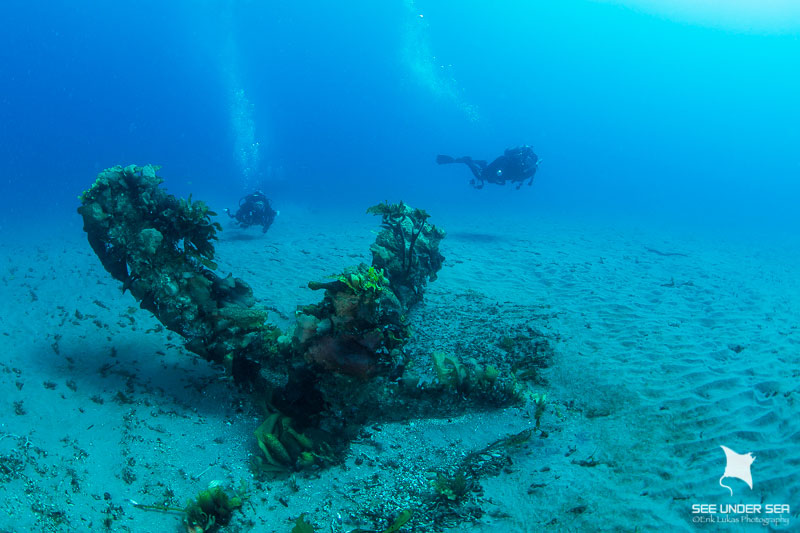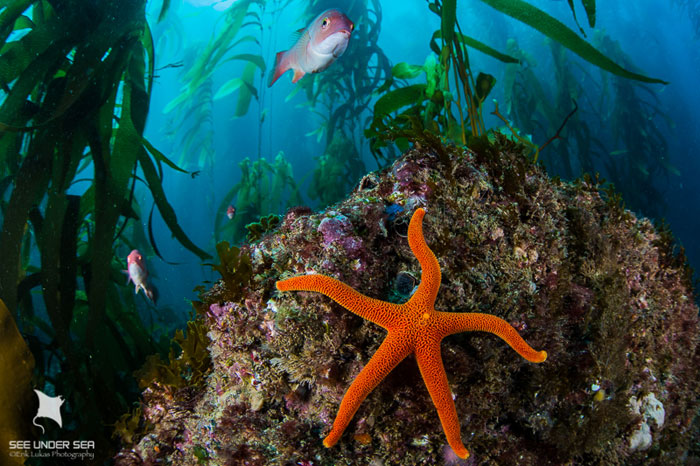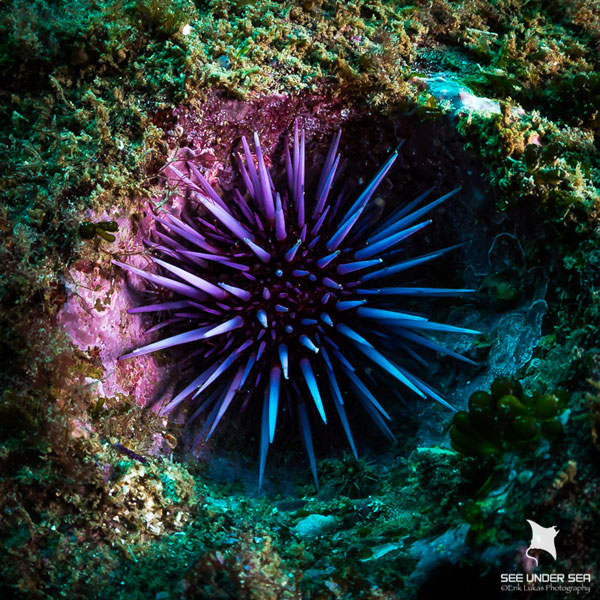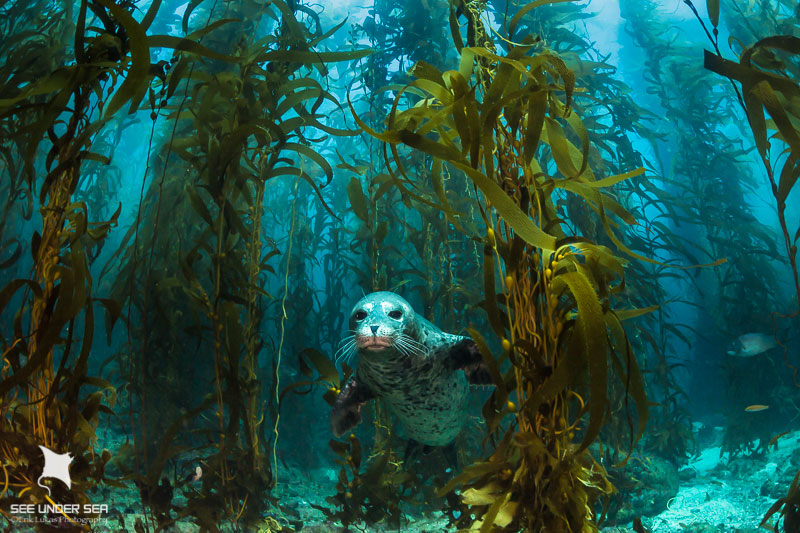An opportunity to visit the far back side of Santa Cruz Island is one I don’t get often and when I do, it is tough to say no. I was invited to join a private charter with four other divers to visit Gull Island. For those who are not familiar with Gull Island, it is a tiny sliver of rock, perhaps 500 ft. across as it’s widest point which sits less than a mile off the southern shore of Santa Cruz Island.
Photos and text by Erik Lukas
Over the years, I have made numerous trips to both Santa Cruz and neighboring Anacapa Islands, but most of those trips tend to be on the eastern and northern side of the islands. Getting to the far back, or south side seems to happen less frequently, due to the distance and sometimes unpredictable conditions. With great, if not downright scorching weather throughout most of Southern California during the entire month of September, we had high hopes for a beautiful day, with sunny skies and calm seas. For this trip we would attempt to dive Gull Island.

Divers approach the propeller assembly of the Grumman Guardian wreck, which broke off and came to rest about 70 feet away from the main fuselage, which was ditched into the Pacific Ocean on March 30, 1954.
I say attempt because it is not always accessible due to it’s exposure to potentially tough diving conditions, as well as the distance from the port of Ventura where most of the larger dive charters operate from. On a private charter, and considerably faster boat, we were able to make the 75 mile round trip in no time. Or so we thought. It turned out that on the day of the dive, there was a fairly strong wind coming out of the NW, which created some less than ideal conditions for our fairly small vessel. The crossing turned into a relative crawl of just 8-10 knots, and a fairly bumpy one as well.
That all changed though as soon as we turned the corner and were provided with some shelter by the island. One of the divers even commented that it was as if we were on a different ocean; a slight breeze and nearly flat conditions allowed us to make up lost time all the way to Gull Island.
While it wasn’t an easy or fast ride over, once we arrived at the dive site we could quickly tell it was worth the effort. We were greeted by the barks of the sea lions and harbor seals enjoying the sunshine on tiny Gull Island. A beautiful kelp canopy was floating on the surface to indicate a lack of any real current. We anchored the boat, geared up, got the cameras ready and splashed for the first of our three planned dives.
Jumping in the water and looking down was all the proof we needed. A clear view of the bottom meant water with visibility of 40-50 feet. Upon descending, one thing that stood out were the Purple Hydrocorals (Stylaster californicus). Now the site was not covered in them as one can expect to find at Farnsworth Banks at Catalina Island, but seeing them in any number is always a treat.

Colorful sea stars, such as this bright orange-red Blood Star (Henricia leviuscula) were in full display. A nice find, with relatively small numbers of healthy sea stars we are seeing due to sea star wasting disease.
The underwater wildlife at Gull Island delivered. Large California Sheephead (Semicossyphus pulcher) were everywhere. Some of the males were among the largest I have seen, and there were plenty of females as well. Fairly large lobsters were tucked into crevices of the reef and some were out leisurely walking among the kelp. I was pleasantly surprised to see a fairly healthy stock of various sea stars, including Bat stars (Asterina miniata), Giant spined stars (Pisaster giganteys), and brightly colored Blood stars (Henricia leviuscula). Also evident at the island were a relatively large number of Purple urchin (Strongylocentrotus purpuratus), which were burrowed into hollowed out holes in the rocky reef.
On our second dive of the day, which we did just a short 100-150 feet away from the first site, the sea lions (Zalophus californianus) came out to play. I had 4-6 who seemed to do large circles at the surface and would dive periodically to buzz by from all directions.
The highlight of the dive was that I had the great pleasure of getting up close to a curious Harbor Seal (Phoca vitulina). She kept approaching me and would rest on the bottom, only to disappear each time I attempted to move in. Once I decided to stay put, she came back and laid down on the bottom 10-12 feet from me, and over the course of the next 10 minutes, would inch closer and closer to me. When she finally made a close approach I was able to get a series of three photos of her in quick succession, as the flash of my strobes sent her off and to the surface. I wouldn’t see her again on that dive, but I did get a photo that I was very pleased with, and a great memory of my 10 minute interaction with her.

A Purple Sea Urchin (Strongylocentrotus purpuratus), sits deep in a burrowed hole on the rocky reef. Areas of the reef were covered in holes ranging from the size of a golf ball, up to a baseball, where urchin spines had carved away at the rock.
The third and final dive of the day was planned to happen on our way back to the mainland, but we took a short detour to check out a site which is the final resting place of a Grumman Guardian AF-2W airplane that was ditched into the Pacific on March 30, 1954. The wreckage sits about 150 feet off of Santa Cruz Island in just over 50 feet of water. Once we located the wreckage, it didn’t take long for the small group of divers to unanimously decide to make our third dive on this wreck.
Being the first to splash, when I looked down we were directly over the wreckage. It was quite a site, as the area around the wreck is a vast expanse of sand; the outline of the plane the only visible object for as far as I could see. A moderate current pulled the sole strand of kelp that has attached to the wreck towards the nose of the plane. Descending on any wreckage is exciting, but for me plane wreckage is always special, even more so when the wreckage is relatively old, and so well intact. While the Guardian is not in perfect condition, it has been in the water for over 60 years, it is well preserved and now home to a host of animals. The one part of the plane that has become separated from the main fuselage are the propellers, sitting to the rear of the plane, at a distance of about 60-70 feet, with the bent blades rising up from the sand.
Our group of divers spent the next 40 minutes exploring the wreckage, taking photos and looking into the remnants of the cockpit, the glass coverings over the wingtip navigation lights, stainless steel cables that looked brand new running from the cockpit to the tail, as well as all of the animals living in and among the wreckage.
It was an unexpected treat to get to dive the Guardian as our last dive on this day, and a perfect way to end a day of diving with good friends at Gull Island. I highly recommend the location for its unique topography, colorful underwater fauna, and as a way to get off the beaten path and explore some of the less visited areas of the beautiful Channel Islands.
• • •
Photos and text by Erik Lukas
.

